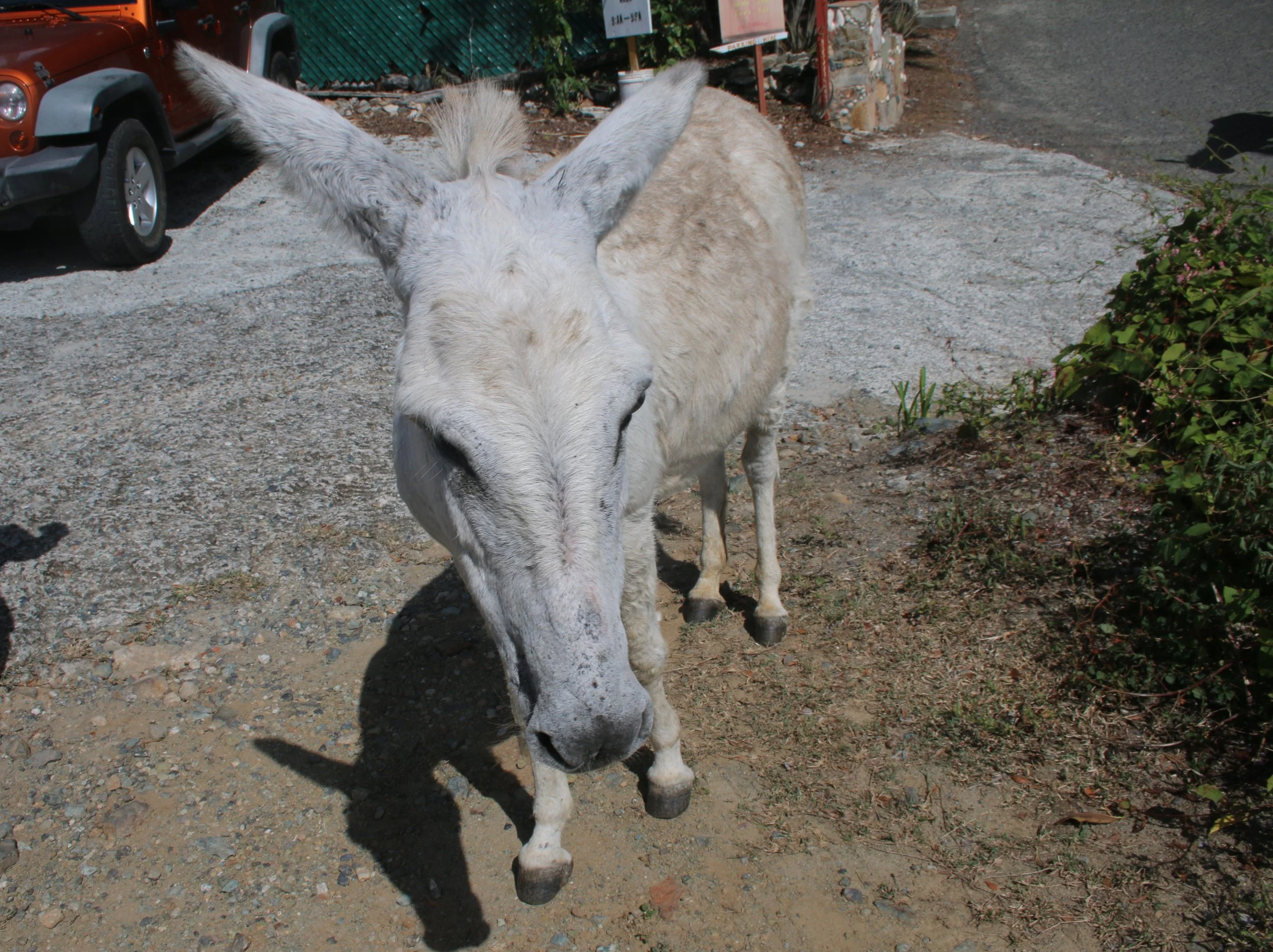St. John Wildlife Rehabilitation: #donkeylife just got a whole lot better for island equines
“It’s not much of a tail, but I’m sort of attached to it.” - Eeyore
St. John Wildlife Rehabilitation has a special equine trailer for hauling on the island’s steep and winding roads. Photo by Carrie Dow.
The wild-roaming donkeys on the US Virgin Island of St. John are Insta-famous with many hashtags tracking their movements. They are as much a part of the island experience as drinking a Bushwacker frozen cocktail or snorkeling in a tranquil bay. But how did they get on a tiny island in the Caribbean Sea and who takes care of them?
Donkeys were brought to St. John by Danish settlers in the 1700s. As pack animals working on sugar plantations, donkeys rotated the grinding wheels that crushed the cane and carried products and building materials up and down the steep hills because there were no roads. When the sugar plantations lost their economic value after slavery was abolished in 1848, the Dutch returned to Europe leaving the donkeys behind.
Today there are an estimated 40-plus donkeys on St. John, most roaming freely in search of food. People are not supposed to feed the donkeys, but they do. This is a dangerous practice as people tend to feed them near roads causing the donkeys congregate near them putting them at risk of getting hit by cars.
For almost two decades Oriel Smith, former Director of Grounds and Landscaping at Caneel Bay Resort, took it upon himself to care for a herd that lived on the grounds and would check on the island’s other herds if anyone called him with concerns. After the 2017 hurricanes, Smith moved to the Orlando area and has not returned because Caneel Bay Resort was never rebuilt. Once again, the donkeys were on their own. Then a local organization stepped up.
Donkeys crossing the road. Photo by Carrie Dow.
According to Pamela Holmes of St John Wildlife Rehabilitation and Donkey Rescue, helping island donkeys is only part of their mission to help St. John’s wildlife, but the equines’ iconic status among visitors makes them the most visible. Officially organized in 2019, Holmes and her East End neighbor Phyllis Benton, had been working as animal rescuers separately for decades. Holmes began with the ASCPA rescuing animals trapped in lower Manhattan after the 9/11 terrorist attacks before becoming certified in rehabilitating rabies vector mammals (racoons, squirrels, rabbits, and other small mammals). Benton, an VI Audubon board member and former co-owner of Crabby’s Water Sports, has a migratory birds rehabilitation permit from US Fish and Wildlife and rescues pelicans, kestrels, doves, and other injured birds. After joining forces and creating St. John Wildlife Rehabilitation, they were approached about the donkeys by another island local named Leslie.
“She’s the one who came to us and said, ‘hey guys, nothing is happening with these donkeys since Oriel left’,” explained Holmes. Wanting to do more for the donkeys, but not sure where to start, they met with St. John veterinarian, Dr. Laura Palminteri, an equine specialist. She put Benton and Holmes in touch with Peaceful Valley Donkey Rescue in Texas, one of the largest donkey rescues in the US.
“They came,” Holmes continued. “They went around and assessed the herd. They helped us deworm and microchip while they were here.”
With support and advice from Peaceful Valley, the new organization had a local welding business build a custom donkey trailer specifically designed for hauling donkeys and other large animals on St. John’s steep and winding roads. Peaceful Valley also helped them acquire metal corral panels to hold the donkeys for deworming. After procuring those items, the rescue came back in January of this year to teach Holmes, Benton, and the other volunteers how to deworm and microchip the donkeys. After chipping and deworming ten donkeys with Peaceful Valley, a crew of local volunteers were able to chip another five on their own about two months later.
“They’re going to be so happy and proud,” beamed Benton, “because [Peaceful Valley] showed us how to do the stuff and this was our first time doing it on our own.”
Donkeys aren’t the only animals on St. John roads. A goat crosses the road near Coral Bay. Photo by Carrie Dow.
The goal is to deworm and microchip all the island’s donkeys.
“Dr. Laura said it not only helps with the overall donkeys’ health,” noted Holmes, “but it then eliminates the parasites so they can’t find another host. So it helps the deer population and then it helps companion animals and people because we all walk the same trails. Those parasites (specifically ticks) are everywhere, but if they don’t have a host, they die. It’s a benefit to everyone.”
Microchipping the donkeys will also help the organization keep track of the herd’s size so they can see how the population is doing, whether they are healthy or not.
Holmes and Benton say the hardest part about helping the donkeys is finding them because they can traverse areas of the island that are difficult, if not impossible, for the truck and trailer to reach. However, they tend to linger near the island’s population centers because that’s where garbage bins and other sources of food are.
“We assemble a core group of at least six individuals, including a two-person search team that heads out first to look for donkeys,” said Holmes. Once they find them, donkeys aren’t exactly known for their cooperativeness.
“Once we know where the donkeys are,” explained Holmes, “we work with corral panels to set up a perimeter, coax the animals in with food, scan the animals to make sure they are not yet microchipped, then safely corral and halter the individual animals. They are given a deworming paste, microchipped, and released.” Benton adds that while locating and set-up take time, once they have the corral panels set, they can help four to five donkeys in an hour.
St. John Wildlife Rehab also rescues island birds. Photo by Carrie Dow.
Despite this added mission to help the island’s donkeys, the organization hasn’t stopped its core rescue program for island birds and mammals. Typically, when island residents find injured or sick animals, they call the organization with Benton and another volunteer handling birds while Holmes handles mammals like island deer. Another volunteer who works for Friends of Virgin Islands National Park specializes in turtle care. In 2021, the organization received over 130 calls. One of the most common calls they get is from residents who found birds injured from crashing into their clear windows. The organization recommends putting decals on windows or perhaps not cleaning them as often, which saves homeowners a lot of time. So far this year, the organization has rescued goats, sheep, chickens, and ducks.
A way for visitors and residents to help St. John’s animals, they recommend NOT feeding the donkeys and staying a safe distance from them as agitated donkeys may bite or kick. They also recommend avoiding oxybenzone sunscreens opting instead for all-natural sunscreens to protect the island’s coral reefs.
For those interested in volunteering for the organization or if you find an injured animal, call 340-643-WILD (9453). Another way to help is monetary donations. Donations help the organization to replenish supplies and pay for any needed veterinary care. Donations can be made through their website.
For Benton and Holmes, putting their skills together has created a successful organization that may be small, but works wonders.
“We are proud of what we have been able to do,” they agreed, “but we could not do it without the assistance of callers who are often willing to help us with these animals.”
It’s OK to take a photo of a donkey for the ‘gram, but do not feed them. Photo by Carrie Dow.












